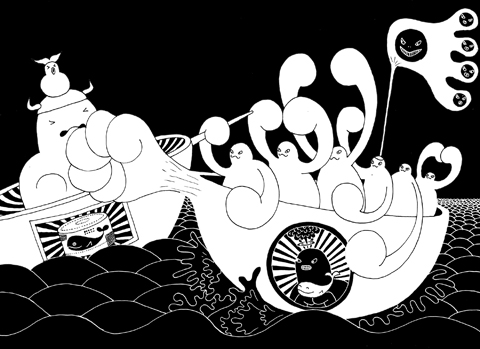Friday, 10:30pm, 61˚ South, 120˚ West. Captain Paul Watson is on the bridge of the Steve Irwin, steaming due west at 17 knots (31.5kph) in heavy seas past the ice floes of Wilkes Land in northern Antarctica.
Roughly 160km ahead of the former Scottish Environment Protection Agency patrol boat, now painted black and flying the jolly roger, is the bulk of the Japanese whaling fleet — mother ship, four harpoon hunter vessels and a security patrol boat — with a license to kill 935 minke, 50 fin and 50 humpback whales in the next few weeks. Behind the Irwin, near the French Antarctic base of Dumont d’Urville, is the Bob Barker, Watson’s second ship. It in turn is being pursued by a second Japanese security ship. Meanwhile, at the bottom of the Southern Ocean is the Ady Gil, the third ship in Watson’s anti-whaling navy. The US$2.5 million space-age catamaran-style, biofuel-powered, ocean-going speedboat sank on Friday morning after being hit by the Shonan Maru 2, one of the Japanese whalers.
“Not hit. Deliberately rammed,” corrects Watson, at 59 still the world’s least compromising and most romantic environmentalist.

On a satellite link he says: “The Gil was almost stationary in the water. [The Shonan Maru 2] changed course abruptly and steered straight into it. One crewman broke two ribs. It was a miracle that no one was killed.”
I had traveled with Watson and the Sea Shepherd Conservation Society from Scotland to the Faroe Islands in 1999. Watson even then was a notorious figure — not unlike Captain Nemo, the Jules Verne character who roamed the depths of the sea in his submarine, the Nautilus.
“Nemo understood that it did not matter what humans thought, because humanity was the problem. His duty was to save life in the sea from the greed of mankind. I understand that philosophy and I have lived it every day of my adult life,” he said.
Back in 1999, his crew of young volunteers were disciplined and clearly in awe of their captain, who accepted no “consensus shit,” “abided no drugs” or “friggin’ in the riggin’,” and who forbade meat-eating aboard his ship. Few had been on a boat before, but everyone had complete confidence in his skills as a mariner and his respect for, and command of, international maritime law. They also expected and hoped for peaceful confrontation and seemed prepared to go to whatever lengths Watson asked of them.
We hunted whalers night and day for a week, but found none. Instead we were buzzed by the Danish air force, boarded by customs officers and ordered by the police to keep away from the islands. When I eventually asked to be put ashore to talk to the Faroese, Watson willingly provided an inflatable and dropped me at midnight on a beach. I was arrested and then imprisoned for illegal entry within minutes. Sea Shepherd clearly has the power to scare communities by doing nothing at all.
Last week, Watson was full of praise for the 77 people from 16 countries, including Japan, who are crewing his three ships this year. In 30 years of harassing industrial fishers, he has taken 4,000 volunteers to Antarctica, the Pacific and the Atlantic to try to stop whaling, sealing and illegal fishing. Few have returned anything other than inspired and committed.
PAST SKIRMISHES
The sinking of the Gil was just the latest skirmish in what has become an annual battle between the volunteers for the California-based Sea Shepherd Conservation Society, which Watson founded after leaving Greenpeace in the 1970s, and the Japanese Institute of Cetacean Research, a scientific research body that has effectively become the Japanese government’s whalers.
For the last nine years, these two small navies have clashed dramatically in the Southern Ocean Whale Sanctuary, an area of 50 million square kilometers in which the International Whaling Commission has banned all types of commercial whaling.
One year the whaling fleet was chased 3,000km through icebergs; another, two Sea Shepherd volunteers were allegedly captured and tied to the railings of a Japanese ship after they had been invited on board. Three years ago, the Japanese allegedly shot at Watson. There have been water cannon battles, and last year the Japanese escalated the war by throwing concussion grenades at the Sea Shepherd boats. Sea Shepherd responded by throwing bottles filled with non-toxic but foul-smelling butyric acid at the Japanese. Each year the accusations have flown and the language has become more colorful.
“We are obsessed with stopping the cetacean Death Star, that vicious, cruel killing machine and her fleet of boats armed with explosive harpoons,” Watson says.
But what precisely happened last week is still not clear. It has been the subject of official protests by both vessels, and will be investigated by the Australian and Japanese governments, and possibly one or more courts. From videos released by both Watson and the Japanese in the last 48 hours, it appears that the Shonan Maru 2 bore down on the Gil with its water cannon blasting and issuing warnings from its loudspeaker that it had “authority to repel.”
No one disputes that it then sliced through the bow of the Gil, scattering its crew of six.
The Japanese accuse Sea Shepherd of being “hostile eco-terrorists.”
“The Sea Shepherd extremism is becoming more violent. Their actions are nothing but felonious behavior. Aiming directly to the Nisshin Maru crew, the activists have repeatedly fired illegal, high-powered laser devices that can produce blindness when irradiated to the naked eye and have fired projectiles containing butyric acid, a substance highly hazardous to the human body including skin and eyes,” a spokesman for the institute said.
Now lawyers working on behalf of Sea Shepherd have lodged papers in a Dutch court accusing the Japanese of “piracy and violence.”
They in turn dismissed his statements as lies and accused Sea Shepherd of pollution and using bows and arrows.
THE PUBLIC EYE
But the private war has become more public and visible thanks to the Internet, and the “whale wars” now threaten diplomatic relations between Australia and New Zealand and Japan. Both antipodean countries are officially embarrassed by the incidents taking place, but have a public overwhelmingly on Watson’s side.
This year the Japanese fleet’s position was relayed to Sea Shepherd not unofficially by the Australian navy, as it has been in the past, but first by small boats near Tasmania, and then by outraged holidaymakers aboard the cruise ship Orion, which happened on the whaling fleet as it was refueling.
Watson is adamant that he is no terrorist.
“In 31 years harassing and confronting whalers, sealers and illegal fishers, we have never injured a single person, never been convicted of a felony, or been sued. Sea Shepherd does not condone, nor do we practice, violence,” he said. “We agree with the assessment by Martin Luther King that violence cannot be committed against a non-sentient object. Sea Shepherd sometimes damages equipment used for illegal activities, but we have an unblemished record.”
“We think [the Japanese] are re-enacting the Second World War,” Watson said on Saturday. “They see themselves as against the West and that no one will tell them what to do.”
But he freely admits damaging property. In a lifetime of confrontations beginning with Canadian sealers, he has used “prop foulers” to sabotage ships, boarded whaling vessels and sunk several in Iceland and Norway.
“We’re not a protest organization — we intervene against illegal activities, and as far as we’re concerned Japanese whalers are poachers. The oceans are being pillaged and we are the only organization out on the high seas trying to do something about it,” he says.
He told me he acted by a martial code culled from the methods of ancient Eastern and modern Western warfare, and that he expected to die for his cause. He quoted films, read widely, wrote poetry and books, laughed a lot.
Watson claims to have co-founded both Greenpeace and Greenpeace International in the early 1970s (something that Greenpeace disputes), but proved far too much for them.
“He was a great warrior brother, yet in terms of the Greenpeace gestalt he seemed possessed by too powerful a drive, too unrelenting a desire to push himself front and center, shouldering everyone else aside,” said his friend Robert Hunter, who died four years ago.
He sailed with Greenpeace many times and skippered one of its boats in 1972. But he severed all links with the organization in 1977 after being expelled from the Greenpeace board.
What he wrote in his autobiography 16 years ago holds just as true today, he says: “There are many people who say that what we do is futile, that there is no way to stop the rising tide of human-spawned destruction. There are many who condemn my crew and I for taking the law into our own hands and for taking on the barons of corporate profit. There are some who would like to see us jailed or even dead, so blinded are they to the conceit and folly of their own anthropomorphism.”
“I don’t care. I do what I do because it is the right thing to do. I am a warrior and it is the way of the warrior to fight superior odds,” he says.

China has not been a top-tier issue for much of the second Trump administration. Instead, Trump has focused considerable energy on Ukraine, Israel, Iran, and defending America’s borders. At home, Trump has been busy passing an overhaul to America’s tax system, deporting unlawful immigrants, and targeting his political enemies. More recently, he has been consumed by the fallout of a political scandal involving his past relationship with a disgraced sex offender. When the administration has focused on China, there has not been a consistent throughline in its approach or its public statements. This lack of overarching narrative likely reflects a combination
Father’s Day, as celebrated around the world, has its roots in the early 20th century US. In 1910, the state of Washington marked the world’s first official Father’s Day. Later, in 1972, then-US president Richard Nixon signed a proclamation establishing the third Sunday of June as a national holiday honoring fathers. Many countries have since followed suit, adopting the same date. In Taiwan, the celebration takes a different form — both in timing and meaning. Taiwan’s Father’s Day falls on Aug. 8, a date chosen not for historical events, but for the beauty of language. In Mandarin, “eight eight” is pronounced
US President Donald Trump’s alleged request that Taiwanese President William Lai (賴清德) not stop in New York while traveling to three of Taiwan’s diplomatic allies, after his administration also rescheduled a visit to Washington by the minister of national defense, sets an unwise precedent and risks locking the US into a trajectory of either direct conflict with the People’s Republic of China (PRC) or capitulation to it over Taiwan. Taiwanese authorities have said that no plans to request a stopover in the US had been submitted to Washington, but Trump shared a direct call with Chinese President Xi Jinping (習近平)
It is difficult to think of an issue that has monopolized political commentary as intensely as the recall movement and the autopsy of the July 26 failures. These commentaries have come from diverse sources within Taiwan and abroad, from local Taiwanese members of the public and academics, foreign academics resident in Taiwan, and overseas Taiwanese working in US universities. There is a lack of consensus that Taiwan’s democracy is either dying in ashes or has become a phoenix rising from the ashes, nurtured into existence by civic groups and rational voters. There are narratives of extreme polarization and an alarming